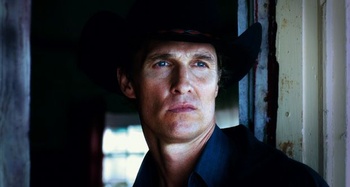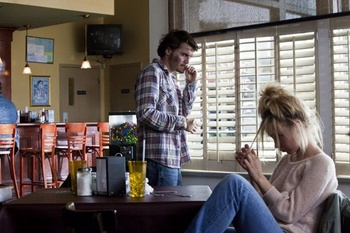Forty years ago, William Friedkin wrote film history with The French Connection and The Exorcist. But the septuagenarian’s work is far from finished. After his sadly underappreciated Bug, he has now made Killer Joe, a jet-black comedy-thriller that has more guts than 99 per cent of American films today. “Hit men are usually great guys.”
“Listen, I have no more goals. Except perhaps something like ‘enjoy life as much as possible while you still can’. I only get excited about work when I encounter material that really impresses me. Like this script did,” the New Hollywood veteran said at the Festival of Fantastic Film, where his new film received wild praise, just as it did in Venice. In Killer Joe, a young drug dealer and his moronic father hire a hit man to murder their mother/wife. The well-kempt professional killer accepts the job on the condition that he gets the underage sister/daughter.
Few of your films are as jet-black, funny, and challenging as Killer Joe. Is that thanks to the fact that you don’t have to make compromises anymore?
William Friedkin: There are still pressures, you know. Killer Joe is a worldwide release. Nobody has asked me to change the film. The only place I’ve had problems is America. The NC-17 rating [you have to be over 17 to see it - NR] is justified, but the consequences are draconian. A lot of cinema chains simply ignore films with that rating. A lot of published media and TV stations refuse to advertise them. That fills distributors with doubt. I could edit Killer Joe so that it gets an R rating, but I simply refuse to do so because then it wouldn’t be my film anymore. And if it happens behind my back, I will have my name removed from the credits. There is still no guarantee of an American release. [Friedkin was to win the war; his version was released in America in August - NR]
What is the problem? Let me guess, the grotesque scene with deep-fried chicken drumsticks?
Friedkin: They usually refer to the graphic scenes; swearing, sex, and violence. They actually called Killer Joe deviant. They don’t like “bad” behaviour, behaviour not in keeping with social norms. Neither I, the writer, nor the cast agree. The characters in Killer Joe show the extremes of human behaviour and what apparently normal people are capable of. That fascinates me. As far as I’m concerned, almost all Hollywood films can rely on special effects, comic book characters, and videogames. But that is not what I want to watch, and it is certainly not what I want to make. I can’t stand inane genre films. I study the crooked timber of which humans are made. “Out of the crooked timber of humanity no straight thing was ever made,” Kant said.
Killer Joe: William Friedkin on hit men


Bug was about paranoia, a topical theme during the last decade. What is Killer Joe about?
Friedkin: About a family falling to pieces, about greed, and about the lengths greedy people will go to. That’s all. You needn’t look for hidden metaphors. Bug didn’t have a hidden message either. It was about becoming so close to someone that you adopt their paranoia, their sickness. Increasingly, I see people adopting the most grotesque ideas from the man or woman they love. Eva Braun had no problem with Hitler’s worldview. A whole country was convinced by his ideas. The question of why still captivates me. How could such an intelligent, creative, refined, and influential society be so convinced by such a madman?
I don’t deal in metaphors and hidden messages. Most of my films are about the fine line between good and evil. Joe is a kind man. He is very attentive to Dotty. He would never treat her the way her father, brother, and mother do. I know a few hit men. Most of them are great guys. They look normal and they are friendly and sociable. I wouldn’t be able to do their job, but they still interest me. One of them used to babysit my son in New York. Uncle Mort was a homicide investigator and a hit man for the mafia. I trusted him completely because he had no reason whatsoever to hurt my son or me.
Just like Bug, Killer Joe is based on a script by playwright Tracy Letts. Do you share his fascination for Tennessee Williams?
Friedkin: Young man, every scriptwriter respects Tennessee Williams, Arthur Miller, and Thornton Wilder. They are three of America’s greatest playwrights. Of course others also wrote interesting things, but not to the same extent. Personally, I think Tracy Letts’s work is very original. He doesn’t owe Tennessee Williams anything. OK, if you look hard you will probably find a link, but there is a much clearer link between Letts and Jim Thompson, the author of bitter, merciless, highly strung novels like The Killer Inside Me. That book, about a corrupt sheriff who batters women and murders people has already been filmed. Jim Thompson was one of Stanley Kubrick’s favourites. Thompson worked on the scripts of both The Killing and Paths of Glory. His work was neglected for a long time, but that seems to be changing with time.
Are you also being revalued? For a long time, you were identified with The Exorcist and The French Connection. But films like Sorcerer and Cruising have been rediscovered recently.
Friedkin: Perhaps, but I’m not aware of it. I would be the last person to know. I don’t read anything about myself.
Friedkin: About a family falling to pieces, about greed, and about the lengths greedy people will go to. That’s all. You needn’t look for hidden metaphors. Bug didn’t have a hidden message either. It was about becoming so close to someone that you adopt their paranoia, their sickness. Increasingly, I see people adopting the most grotesque ideas from the man or woman they love. Eva Braun had no problem with Hitler’s worldview. A whole country was convinced by his ideas. The question of why still captivates me. How could such an intelligent, creative, refined, and influential society be so convinced by such a madman?
I don’t deal in metaphors and hidden messages. Most of my films are about the fine line between good and evil. Joe is a kind man. He is very attentive to Dotty. He would never treat her the way her father, brother, and mother do. I know a few hit men. Most of them are great guys. They look normal and they are friendly and sociable. I wouldn’t be able to do their job, but they still interest me. One of them used to babysit my son in New York. Uncle Mort was a homicide investigator and a hit man for the mafia. I trusted him completely because he had no reason whatsoever to hurt my son or me.
Just like Bug, Killer Joe is based on a script by playwright Tracy Letts. Do you share his fascination for Tennessee Williams?
Friedkin: Young man, every scriptwriter respects Tennessee Williams, Arthur Miller, and Thornton Wilder. They are three of America’s greatest playwrights. Of course others also wrote interesting things, but not to the same extent. Personally, I think Tracy Letts’s work is very original. He doesn’t owe Tennessee Williams anything. OK, if you look hard you will probably find a link, but there is a much clearer link between Letts and Jim Thompson, the author of bitter, merciless, highly strung novels like The Killer Inside Me. That book, about a corrupt sheriff who batters women and murders people has already been filmed. Jim Thompson was one of Stanley Kubrick’s favourites. Thompson worked on the scripts of both The Killing and Paths of Glory. His work was neglected for a long time, but that seems to be changing with time.
Are you also being revalued? For a long time, you were identified with The Exorcist and The French Connection. But films like Sorcerer and Cruising have been rediscovered recently.
Friedkin: Perhaps, but I’m not aware of it. I would be the last person to know. I don’t read anything about myself.
Could you have gotten more out of your career?
Friedkin: There aren’t many things I still want to do. That used to be different. I would have liked to make a documentary about René Magritte or Marcel Proust. There are many films I would have liked to make but didn’t. I worked on many of them for a long time, but to no avail. The Exorcist took three years to make. There is an enormous amount to do: scriptwriting, preparations, casting, location hunting, rehearsals, filming, going to Iraq to shoot the prologue, editing, supervising the international versions, promotion. The French Connection took two years. I was no Jean-Luc Godard who could just film spontaneously. Every film became an obsession. Not all of my films were worth it, but some were. I take comfort in that.
I see you have been given the René Magritte Suite. How appropriate. The poster of The Exorcist clearly refers to L’Empire des lumières, doesn’t it?
Friedkin: Magritte painted eight variations. I saw number four – with the sky in daylight and the lamppost on the dark, wet street – at the Museum of Modern Art (MoMA) in New York, in the period that I was thinking about how to shoot The Exorcist. L’Empire des lumières inspired the filming of the key scene in The Exorcist.
I hope to visit the Magritte Museum tomorrow. I would have liked to visit Oostende for James Ensor and Paul Delvaux as well, but I won’t have time. But it has struck me how omnipresent surrealism is in Brussels.
Killer Joe ●●●
US, 2011, dir.: William Friedin, act.: Matthew McConaughey, Juno Temple, Emile Hirsch, 102 min.
Friedkin: There aren’t many things I still want to do. That used to be different. I would have liked to make a documentary about René Magritte or Marcel Proust. There are many films I would have liked to make but didn’t. I worked on many of them for a long time, but to no avail. The Exorcist took three years to make. There is an enormous amount to do: scriptwriting, preparations, casting, location hunting, rehearsals, filming, going to Iraq to shoot the prologue, editing, supervising the international versions, promotion. The French Connection took two years. I was no Jean-Luc Godard who could just film spontaneously. Every film became an obsession. Not all of my films were worth it, but some were. I take comfort in that.
I see you have been given the René Magritte Suite. How appropriate. The poster of The Exorcist clearly refers to L’Empire des lumières, doesn’t it?
Friedkin: Magritte painted eight variations. I saw number four – with the sky in daylight and the lamppost on the dark, wet street – at the Museum of Modern Art (MoMA) in New York, in the period that I was thinking about how to shoot The Exorcist. L’Empire des lumières inspired the filming of the key scene in The Exorcist.
I hope to visit the Magritte Museum tomorrow. I would have liked to visit Oostende for James Ensor and Paul Delvaux as well, but I won’t have time. But it has struck me how omnipresent surrealism is in Brussels.
Killer Joe ●●●
US, 2011, dir.: William Friedin, act.: Matthew McConaughey, Juno Temple, Emile Hirsch, 102 min.
Read more about: Film
Fijn dat je wil reageren. Wie reageert, gaat akkoord met onze huisregels. Hoe reageren via Disqus? Een woordje uitleg.